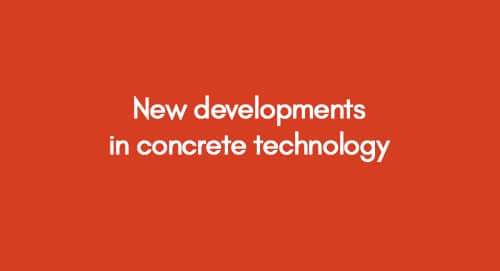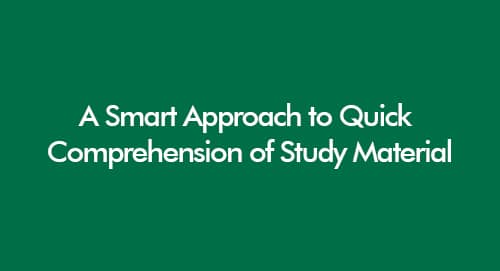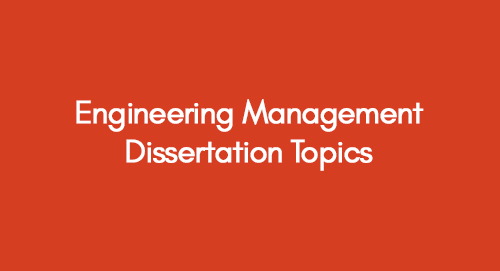
160 Creative Engineering Management Dissertation Topics in 2025
January 19, 2021
Benefits of Managed Motorways
January 27, 2021In the dynamic landscape of construction, concrete technology is unfurling novel possibilities, where ingenuity converges with resilience, sculpting a future where structures embody not just engineering excellence but also exemplify a harmonious blend of sustainability and cutting-edge design.
Concrete is the foundation of modern construction. This versatile material has played a pivotal role in shaping our urban landscapes, from towering skyscrapers to intricate bridges and highways. Over the years, concrete technology has seen significant advancements, ushering in an era of improved durability, sustainability, and innovation.
Explore More About Concrete Technology
Concrete, a material with an ancient history, is at the forefront of modern construction. Researchers and engineers constantly push the boundaries of what concrete can do in the quest for stronger, more sustainable, innovative building solutions. In this blog, we'll delve into some exciting new developments in concrete technology, demonstrating how this age-old material continues to evolve and meet the challenges of the 21st century.
Introduction
Concrete stands out as the most extensively utilized construction material globally, playing a pivotal role in erecting and refurbishing various infrastructures. The widespread preference for Portland cement concrete is primarily attributed to its cost-effectiveness in both construction and maintenance. Two key driving factors fueling advancements in concrete technology are the pursuit of enhanced concrete durability and the demand for accelerated construction processes.
Emerging Developments
Recent advances in concrete technology have introduced a range of pullout tests aimed at gauging the pouring consistency of lightweight concrete and assessing its holding strength. Concrete products have attained remarkable compressive strength levels by combining a low water-to-cement ratio and meticulous mixing techniques (Collepardi, 1994; Fukute, 2005).
Reducing the amount of water used in each mixing stage can lead to concrete that takes up to 14 days to reach a moisture content equilibrium with the surrounding atmosphere. However, there are emerging technologies that can expedite this process, allowing equilibrium to be reached within just 6 days.
Research has demonstrated that low water content in concrete enhances bonding strength with various surfaces, including concrete decks and metals. To facilitate this, self-contained concrete mixtures equipped with pumps and foam-generating devices have been developed.
To summarize, the Institute of Concrete Technology has spearheaded various pullout tests designed to evaluate the consistency of lightweight concrete and its holding strength. These tests have showcased the potential to achieve concrete products with remarkable compressive strength by optimizing the water-to-cement ratio and adhering to meticulous mixing procedures. Additionally, emerging technologies supported by the Institute expedite the concrete's moisture equilibrium. This, in turn, strengthens bonds with diverse surfaces. Furthermore, the Institute's initiatives have led to the development of self-contained concrete mixtures equipped with foam generation capabilities, streamlining the construction process. Below, we delve into some new advancements that hold promise for the concrete industry.
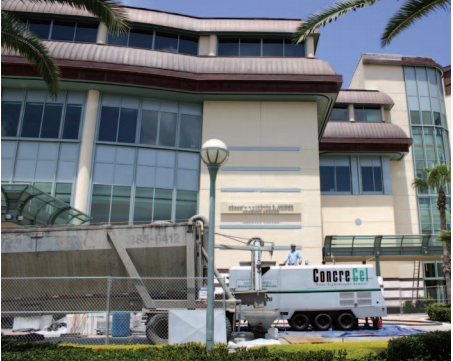
Figure 1: The Concrete USA pumping equipment is fully automated and self-contained. Use to weigh cement and contains foam
Ultra-High Strength Concrete
Recent advancements have created high-strength concrete with unique combinations of superior tensile strengths, durability, compressive strengths, and ductility. Using ultra-high-strength concrete in construction allows for the development of more durable and lighter structures while accommodating specific structural load requirements. Furthermore, structures constructed using ultra-high-strength concrete are more sustainable, as they demand reduced energy and raw materials, resulting in fewer CO2 emissions (Malhotra, 1997).
Reducing the water-to-cement ratio (w/cm) has paved the way for producing low-permeability materials that exhibit remarkable durability, even in harsh and aggressive environments. In certain applications, high-strength concrete is preferred not solely for its strength but for its durability. This preference is especially evident in constructing undersea tunnels, offshore oil platforms, long-span bridges, and other marine concrete structures. Additionally, there is an observed development of super-plasticized concrete with high strengths to improve material flow and prevent segregation (Sivasundaram et al., 1994).
To enhance the workability of super-plasticized concrete, various admixtures can be employed. The most commonly used admixtures possess cementitious and pozzolanic characteristics, including fly ash, furnace slag with ground granulated base, and silica fumes (Morgan, 1994).
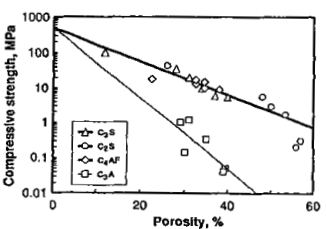
Figure 2: Porosity vs. strength relationship source: (Beaudoin and Ramachandran, 1992)
The advent of new developments in concrete technology has led to substantial reductions in construction costs. These innovations have streamlined various construction processes, making concrete mixing and pumping more efficient. Notable examples of cost savings can be seen in the construction of offshore structures and high-rise buildings.
Pre-stressed concrete fabrication and heavy reinforcement use in tight spaces are one area where cost benefits have become apparent. This represents a specialized application of the new concrete technology, resulting in significant cost reductions and enhanced construction capabilities.
High-Performance Concrete
Concrete mixtures possessing exceptional attributes such as high strength, workability, and durability fall under high-performance concrete. The mandatory requirement for outstanding durability sets high-performance concrete apart from high-strength concrete. Sometimes, these concrete mixtures are formulated for applications demanding high dimensional stability.
The latest concrete technology emphasizes restricting the paste content within the concrete mixture to create exceptionally durable concrete. This durability ensures that the concrete can endure diverse environmental conditions throughout its service life without developing detrimental cracks due to drying or thermal shrinkage. Recent advancements in the field have introduced innovative proportioning techniques for high-performance concrete mixtures, as elucidated by Malhotra in 1994.
These proportioning methods suggest restricting the cement paste content to one-third of the total concrete volume. They also allow for partial substitution of Portland cement with admixtures like pozzolanic or cementitious materials. Many of these new technologies favour using ternary cement blends containing substances like silica fumes, slag, fly ash, limestone, rice husk, and metakaolin (Roy and Silsbee, 1994).
Incorporating these elements has produced synergistic effects, enhancing the freshness and strength of the concrete. This, in turn, has made high-performance concrete a more cost-effective choice while maintaining its exceptional properties.
Carbon Dioxide Absorption
Recent advancements in concrete technology have unveiled the remarkable capability of concrete to capture carbon dioxide (CO2) from the atmosphere. Research has indicated that the carbonation process within concrete is accountable for over 50 per cent of CO2 emissions during the initial cement production. Consequently, various technologies have been devised to effectively mitigate CO2 emissions, safeguarding the environment against harmful compounds (Hayakawa, 1995).

Figure 3: Depth of carbonation source (Beaudoin and Ramachandran, 1992)
Nanotechnology
Nanotechnology is one of the most dynamic and globally active research fields. Its applications have extended successfully into diverse areas like machine components, electronics, and biomechanics. Nanotechnology is gaining considerable attention in concrete technology, with emerging researchers contributing significantly to novel developments (Richard and Cheyrezy, 2004).
One noteworthy breakthrough involves substantially reducing heating temperatures during cement production by incorporating nanocatalysts (Mehta and Aïtcin, 1990). This development has the potential to minimize CO2 emissions and reduce energy consumption during the cement manufacturing process.
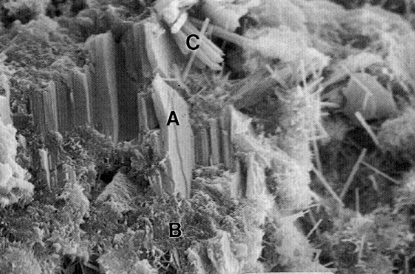
Figure 4: Hydrated cement paste of 0.55 W/C concrete, where A = CH, B = C-S-H, and
C = ettringite needles
Additional advancements encompass the utilization of nano-silica, which consists of tiny silicon dioxide particles, in ultra-high-performance concrete. Innovations extend to creating cementitious components founded on nano-engineered particles and nano binders. Integrating carbon-based nanotubes into concrete mixtures results in stronger, more durable, ductile, and sustainable cement. Furthermore, recent developments have surfaced in producing superplasticisers for enhanced water reduction and precise workability management.
Cathodic Protection of Reinforced Concrete
Galvanic cell current flow can be effectively controlled by applying cathodic protection techniques. These methods employ surface-level anodes and deliver current from opposing directions. An external current application method can be employed for protection when it comes to safeguarding concrete structures vulnerable to corrosion due to chloride contamination.
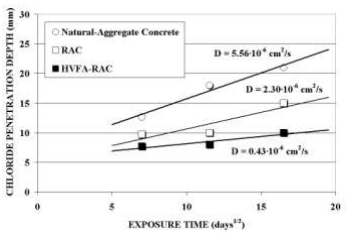
Figure 5: Depth of chloride penetration source (Beaudoin and Ramachandran, 1992)
The research findings have revealed that the accumulation of potassium and sodium ions leads to the deterioration of bonds between concrete components, particularly steel. This phenomenon causes a weakening of the interface where steel and concrete meet, observed due to the increased presence of these ionic bonds (Swamy and Tanikawa, 1990). Furthermore, an elevation in the chloride content within the concrete directly correlates with an increase in current density, further exacerbating the degradation of the interface between steel and concrete.
Surface Coatings
Concrete surfaces can be safeguarded against external threats by utilizing barrier or surface coatings. A diverse array of these barrier coatings is at one's disposal, effectively protecting against the deterioration of concrete surfaces. Recent advancements have highlighted the significance of diffusion characteristics of various coatings, which exhibit properties similar to concrete compositions.
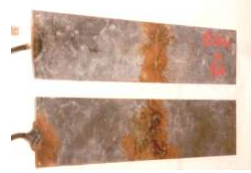
Figure 6: Visual corrosive attack on steel embedded in concrete
Applying a rubber coating with remarkably low diffusion coefficients and advanced engineering attributes, particularly its acrylic properties, is gaining popularity as a concrete coating (Richard and Cheyrezy, 2004). This rubber coating has demonstrated its efficacy in enhancing durability by effectively managing the detrimental consequences of alkali and silica expansions in concrete. These advancements are part of ongoing efforts to introduce cost-effective, high-performance coatings in concrete technology.
Conclusion
This report assesses the progress in concrete technology and its impact on the construction industry. Recent developments in concrete technology have been examined, focusing on evaluating their effects. An arbitrary rating system has been established to provide a comprehensive evaluation, considering factors like life cycle cost, construction cost, initial material cost, environmental consequences, and the future implications for the entire concrete industry. Each technology development has been assigned grades ranging from low to medium and high based on their attributes.
Sustainable development in the concrete industry can be pursued by adopting sustainable technologies. This includes strategies to reduce energy consumption, conserve natural resources, and minimize CO2 emissions. The enhancement of cement manufacturing technology, particularly through the increased utilization of supplementary cementing materials, contributes to these sustainability efforts.
Efforts should also be directed towards recycling concrete and its constituents. Coating structures with durable and effective materials can extend their service life. Integrating emerging technologies in the concrete industry is crucial in ensuring consistent growth in the construction sector. Contractors are encouraged to prioritize codes and specifications that emphasize performance-based criteria. Instead of focusing solely on initial costs, contractors should consider life cycle costs to create long-lasting, durable concrete structures.
References
- Beaudoin, J. J., and Ramachandran, V. S. (1992), A New Perspective on the Hydration Characteristics of Cement Pastes, Cem. Concr. Res., 22:689–694
- Collepardi, M. (1994), “Super-plasticizers and Air-Entraining Agents —State of the Art and Future Needs,” Concrete Technology: Past, Present, and Future, SP-144, American Concrete Institute, Farmington Hills, Mich., pp. 399-416.
- Fukuda, T.; Moriwaka, A.; Sano, K.; and Hamasaki, K. (2005), “Development of Super-workable Concrete for Multi-functional Structures, ibid” pp. 335-356
- Hayakawa, M.; Matsuoka, Y.; and Yokota, K. (1995), “Application of Super-workable Concrete in the Construction of a 70-story Building in Japan,” Advances in Concrete Technology, SP-154, American Concrete Institute, Farmington Hills, Mich., pp. 381-398.
- Mehta, P. K., and Aïtcin, P. C. (1990), “Principles Underlying the Production of High-Performance Concrete,” Cement, Concrete, and Aggregates, ASTM, V. 12, No. 2, pp. 70-78
- Malhotra, V. M. (1994), “CANMET Investigations Dealing with High Volume Fly Ash Concrete, Advances in Concrete Technology, editor: V. M. Malhotra, CANMET, Ottawa, Canada, pp. 445-482
- Morgan, D. R. (1994), “New Developments in Shotcrete of Repair and Rehabilitation,” Advances in Concrete Technology, CANMET, Ottawa, pp. 675-720.
- Malhotra, V. M. (1997), “Innovative Applications of Super-plasticizers in Concrete — A Review,” Advances in Concrete Science and Technology, Proceedings, M. Collepardi Symposium, Rome, pp. 271-314.
- Roy, D. M., and Silsbee, M. R., (1994) “Novel Cements and Concrete Products for Application in the 21st Century,” Concrete Technology, Past, Present, and Future, SP-144, American Concrete Institute, Farmington Hills, Mich, pp. 349-382.
- Richard, P., and Cheyrezy, M. H. (2004), “Reactive Powder Concretes with High Ductility and 200-800, MPa Compressive Strength, ibid” pp. 507-518.
- Swamy, R. N., and Tanikawa, S. (1990), “Surface Coatings to Preserve Concrete Durability,” Protection of Concrete, Chapman and Hall, pp. 149-165.
- Sivasundaram, V.; Bilodeau, A.; and Malhotra, V. M. (1995), “Effect of Curing Conditions on High-Volume Fly Ash Concrete Made With ASTM Type I and III Cements and Silica Fume,” Advances in Concrete Technology, SP-154, American Concrete Institute, Farmington Hills, Mich., pp. 509-530.
Get 3+ Free Dissertation Topics within 24 hours?

















